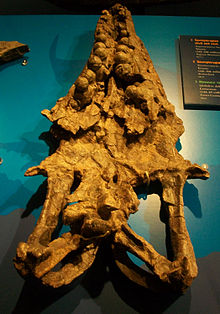Globidens
|
Globidens Temporal range: Late Cretaceous, 84.9–66 Ma |
|
|---|---|
 |
|
| Skull of G. dakotensis (bottom view) in the Field Museum of Natural History, Chicago. | |
| Scientific classification | |
| Kingdom: | Animalia |
| Phylum: | Chordata |
| Class: | Reptilia |
| Order: | Squamata |
| Superfamily: | †Mosasauroidea |
| Family: | †Mosasauridae |
| Tribe: | †Globidensini |
| Genus: |
†Globidens Gilmore, 1912 |
| Species | |
|
|
Globidens ("Globe teeth") is an extinct genus of mosasaur lizard classified as part of the Globidensini tribe in the Mosasaurinae subfamily.
Globidens alabamaensis was the first species of Globidens described, in a publication by Charles W. Gilmore (1912). It is used as the type specimen for Globidens.
Globidens belongs to the family Mosasauridae, which consists of several genera of predatory marine reptiles prevalent during the Late Cretaceous. Specimens of Globidens have been discovered in North America and parts of Africa and Asia (Indonesia). Among mosasaurs, Globidens is probably most well known for its highly rounded, globe-like teeth.
Globidens was ~6 m (20 ft) in length and in appearance very much like other mosasaurs (streamlined body with flippers, a laterally flattened tail and powerful jaws). The teeth of Globidens differed from those of other mosasaurs in being globular, giving rise to its generic name. Generally, most mosasaurs had sharp teeth evolved to grab soft, slippery prey like fish and squid, which in some later species were modified to rend flesh, as well. While many other mosasaurs were capable of crushing the shells of ammonites, none were as specialized for dealing with armored prey as Globidens. Globidens had semispherical teeth with rounded nubbin-like points, which were much better suited for crushing tough armored prey like small turtles, ammonites, nautili, and bivalves. Like its larger relative, Mosasaurus, Globidens had a robustly built skull with tightly-articulating jaws. Such features no doubt played a large role in its ability to penetrate the armor of its shelled prey.
...
Wikipedia
